Author(s): Glen Wash Ivanovic & Junko Tamura
The present research is focused on an architectural reevaluation of the Sites andServices schemes implemented in the Dandora community, located in the easternoutskirts of Nairobi, Kenya.The Sites and Services approach is a well-known set of principles and steps aimedto provide housing to low-income people in developing countries. The core characteristicof the Sites and Services was the inclusion of the low-income potentialhouseholders in the process of implementation and construction of their houses.Basically, government agencies were to provide a plot of land and the essentialurban infrastructure (roads, electricity, water supply, etc.) while the design andconstruction of the houses was the beneficiary’s responsibility, assuming thatthe promise of land tenureship or ownership would encourage and stimulate thesuccess of the self-building process. This approach was strongly promoted by theWorld Bank, which provided financial and technical assistance to local governmentsin developing countries for its implementation. Several countries in Asia,Africa and South America were engaged in Sites and Services projects during thelate seventies and eighties, when the approach became a paradigm for solving theslums and squatters problem. While these projects needed specific strategies andmodifications for adapting to the particularities of the places they were implemented,they always incorporated different degrees of collaboration between thelocal government and the beneficiary.Today, many of these projects are considered unsuccessful. They were actively revisitedand reevaluated soon after their implementation, and it is generally agreedthat, because of many complex reasons, Sites and Services had a number of shortcomingsduring its execution.The Dandora community in Nairobi is often cited as an example of these shortcomings,usually because most of the beneficiaries of the project moved elsewhere,either selling or renting the received plots without actively engaging in the constructionof the houses. However, most of these reevaluations were done duringthe late eighties, and from a housing policies perspective. Since then, Dandora hasreceived little attention, especially in terms of the resulted architecture and thecommunities which have produced it, regardless if they are the original ownersor not.For this case study, we revisited a specific area of Dandora phase one, which isregarded as the one with the best environmental quality both by local authoritiesand residents. We recorded the actual state and planning of the self-built houses,while also interviewing the current tenants, aiming to identify the pros and consof the resulted typologies.The analysis shows that, while there are indeed shortcomings for the Dandora project,it still has produced unforeseen and positive results, yet still valuable on an architecturaland communal level, which could be used for future developments incollaborative design and approaches to the slum and housing problem.
Volume Editors
Alice Kimm & Jaepil Choi
ISBN
978-0-935502-91-6

 Study Architecture
Study Architecture  ProPEL
ProPEL 
